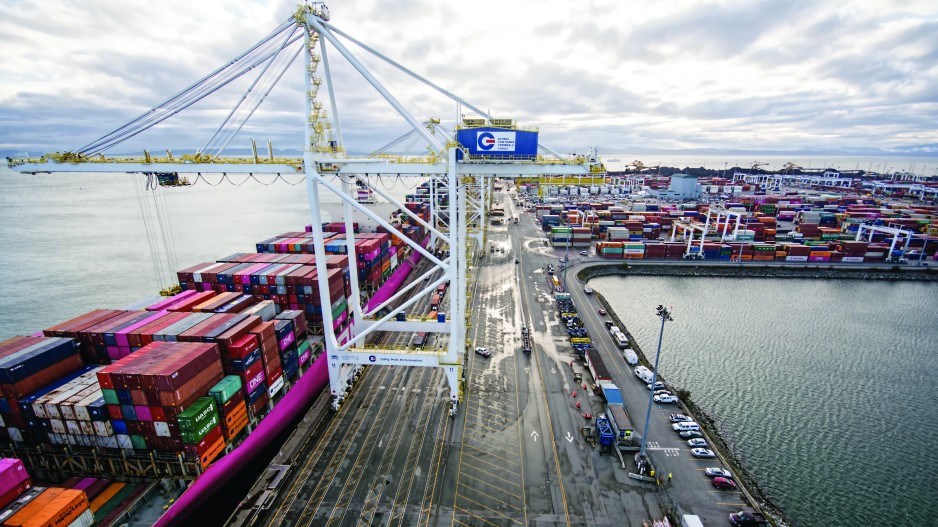Less traffic, less congestion, but no less volatility and no fewer complications.
And, despite a steep drop in transpacific spot rates for containers, no reduction in bottom-line buoyancy for ocean container carriers, which has been historically profitable since the latter half of 2022.
At least in the short-term.
That is the conclusion of shipping data and the analysis of container cargo shipping experts.
The longer term for Vancouver and other major West Coast North America ports is less upbeat. The prospects of China’s reduced manufacturing production and the ongoing diversion of transpacific freight flow to Gulf and East Coast ports should be concerning for their West Coast counterparts.
As New York-based container shipping analyst John McCown noted in a September report, inbound container volume to West Coast North America ports dropped 17 per cent compared with the previous month while inbound container volume to East and Gulf coast ports increased 6.6 per cent. McCown added that West Coast ports have recorded year over year decreases in nine of the last 13 months.
The migration of more ships through the widened Panama Canal to less congested ports in the Gulf of Mexico and along the East Coast of North America is not new.
McCown notes that September was the “16th straight month where the year-over-year per cent change in volume at East/Gulf Coast ports outperformed West Coast ports.”
His report points out that the gap in gains for East/Gulf coast ports compared with West Coast ports in September was the second highest over the past 16-month period.
The good news for major retailers and other companies that rely on containerized cargo shipping companies for imports and exports is that port congestion is easing along with reduced demand, and container shipping rates have dropped significantly since 2022’s first quarter.
According to Shifl, a New York-based digital freight forwarding company, container cargo ship transit times from China to West Coast North America have decreased 60 per cent from their highs in December 2021.
Transit data measures the time it takes for a cargo container to leave its port of origin until it is unloaded at its destination terminal.
Meanwhile, freight rates for a standard 40-foot container from China to the West Coast have dropped to US$1,825, which is roughly the peak shipping season rate prior to the pandemic.
That rate during the peak of transpacific congestion and dysfunction in September 2021 had jumped to US$17,500.
Lower freight rates could help cool inflation in North America.
Shabsie Levy, Shifl’s CEO and founder, noted that while the U.S. Federal Reserve recently raised the federal funds rate target range to between three and 3.25 per cent and inflation remains high, “it is expected that the fall in spot freight rates will eventually alleviate inflation. It remains to be seen whether the rates will stabilize at pre-pandemic levels or will fall lower than that.”
But McCown has estimated that the difference in aggregate pricing for marine cargo in 2022’s second quarter compared with 2019’s fourth quarter is approximately US$99.2 billion. That additional cost is now embedded in all categories of maritime cargo movement, his report points out, and most of the freight being moved is priced in one-year contracts.
So, even if spot freight rates continue to drop, a large portion of freight movement is subject to pricing based on one-year contracts. It will therefore take some time for overall shipping rates to match up with the spot market.
The maritime container cargo sector is therefore on course to reap massive profits for 2022.
According to data from Drewry, a U.K.-based global shipping consultancy, industry-wide second quarter earnings will be US$84 billion.
“And really just to show how wild the ride has been over the past two years,” said Simon Heaney, Drewry’s senior manager of container research, “since the second quarter of 2020, the industry’s rolling EBIT [earnings before interest and taxes] profit is now running at over US$400 billion and counting.… Although we don’t necessarily have the data going all the way back. We believe it’s more than the container industry has made in the entirety of 50-plus years of containerization.”
Drewry estimates that the sector’s 2022 EBIT will hit a staggering US$275 billion and then cool off slightly to US$100 billion in 2023.
Presenting Drewry’s data at a recent market update for the global container shipping sector, Heaney pointed out that financial numbers are lagging indicators of what is happening in any industry.
But the astonishing profit wave that ocean container carrier companies have been riding over the past 18 months is showing increased signs of slowing.
Heaney pointed out that spot rates for containerized freight have been slipping for more than 30 weeks in a row.
He added that charter rates for container ships have dropped by around two-thirds since their peak, and trade volumes in many regions are slowing.
@timothyrenshaw




